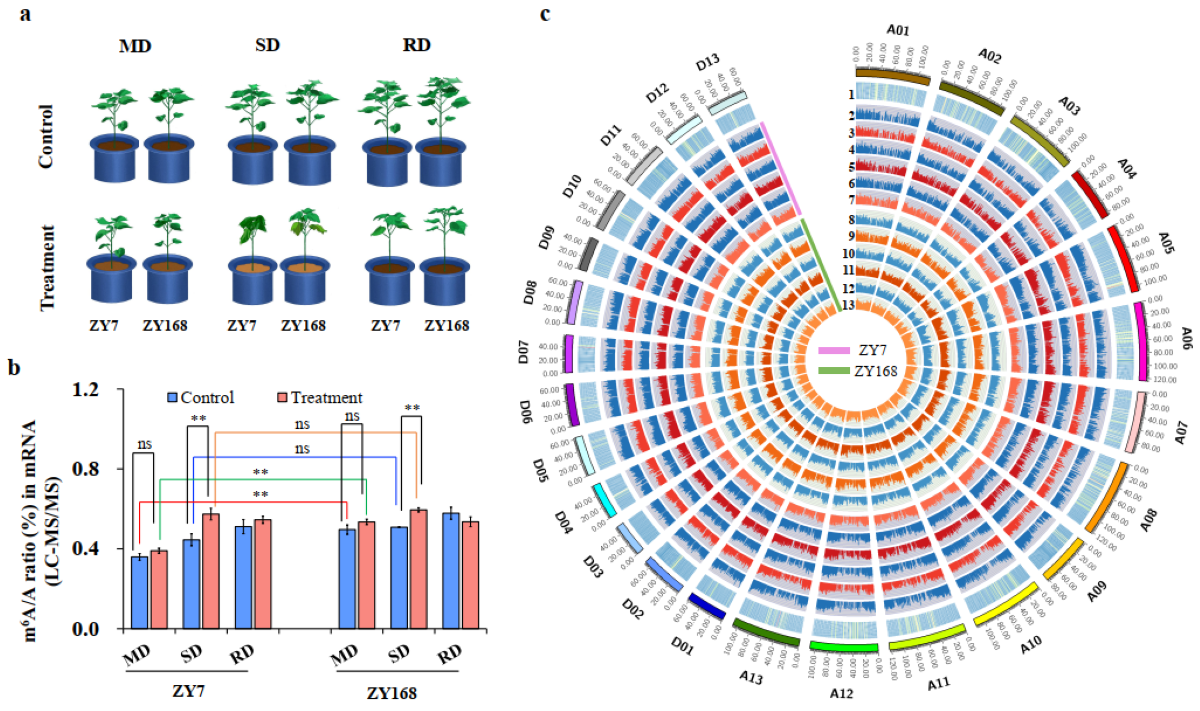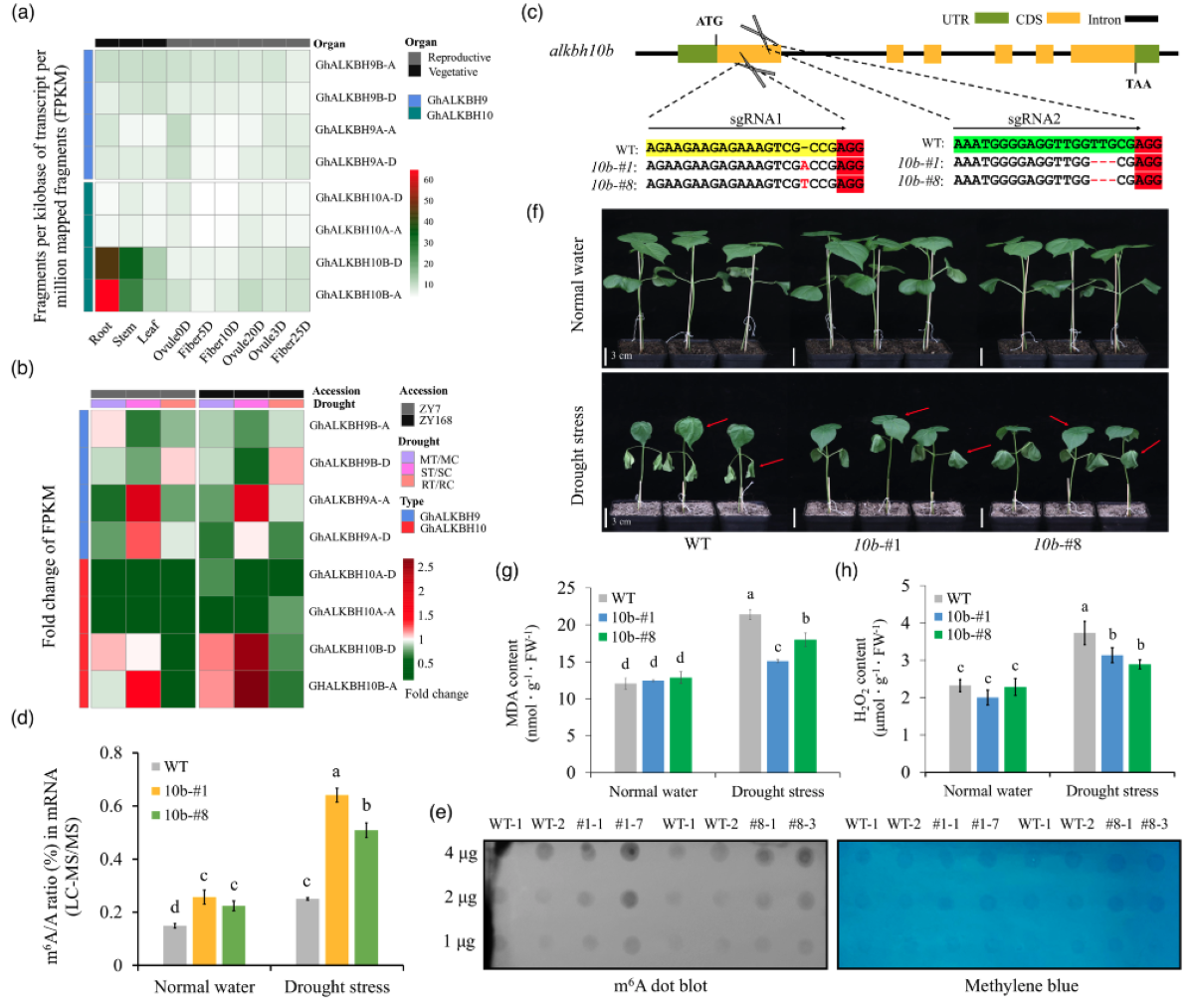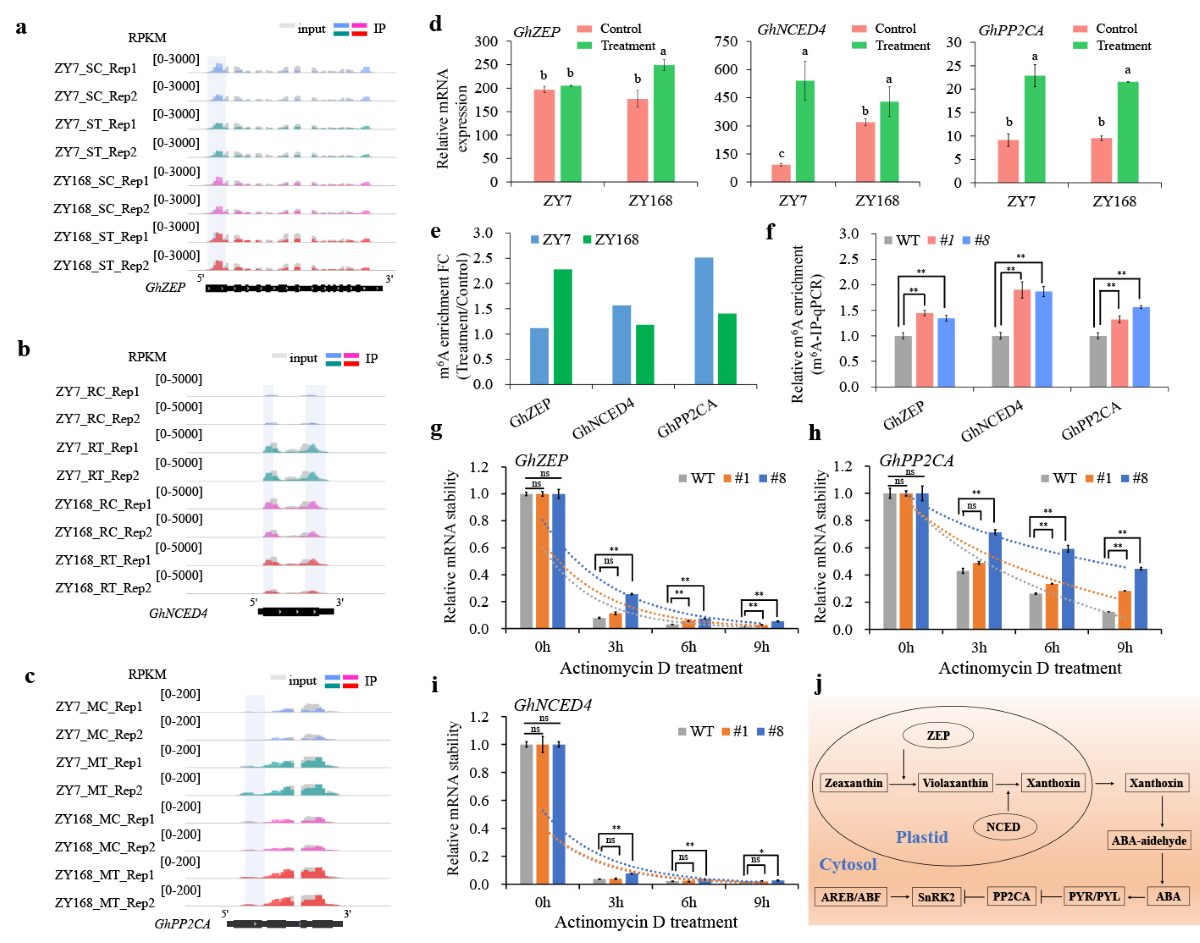南湖新闻网讯(通讯员 李保奇 张萌萌)近日,我校植物科学技术学院棉花团队在Plant Biotechnology Journal在线发表题为“N6-methyladenosine RNA modification regulates cotton drought response in aCa2+and ABA-dependent manner”的研究论文,研究揭示棉花去甲基化酶GhALKBH10B通过介导ABA和Ca2+信号传导途径中的重要基因的去m6A甲基化修饰调控棉花干旱应答及抗旱性机制。
棉花是重要的经济作物,棉纤维是纺织工业的主要原料。随着我国棉区向新疆转移,干旱胁迫成为影响棉花生产的主要非生物逆境因素。研究棉花干旱胁迫应答的分子机制,挖掘抗旱的关键调控因子并加以利用,进而培育耐旱性棉花品种,是解决棉花抗旱资源贫乏及提高水资源利用率的有效途径。植物对干旱的应答在基因组、转录和转录后水平上都受到高度调控。N6-甲基腺苷(m6A)是最常见的mRNA修饰,在人类、动物、植物等多个物种中均发挥着重要调控作用。在植物中,m6A主要参与植物发育、逆境响应等生物学过程。目前,棉花抗旱机制的研究大多停留在基因转录水平的调控,棉花干旱应答过程在转录后mRNA修饰层面的调控机制仍不清楚。

图1 棉花抗旱、敏旱品种全转录组m6A修饰图谱
本研究利用团队前期筛选到的抗旱性存在显著差异的抗旱棉花品种ZY168和敏旱品种ZY7,通过MeRIP-seq构建干旱处理不同时期(轻度干旱,MD;重度干旱,SD;干旱复水期,RW)棉花全转录水平的m6A修饰图谱(图1)。对棉花干旱响应m6A修饰模式的分析发现,棉花中m6A修饰主要集中在基因的3′UTR区;干旱胁迫使m6A含量升高,且抗旱和敏旱品种在干旱胁迫下表现出m6A分布的显著差异,即在干旱胁迫下抗旱品种5′UTR区富集了更多的m6A。对m6A修饰基因的表达分析表明,m6A修饰通过调节关键基因mRNA丰度正调控棉花抗旱性。

图2 GhALKBH10B参与棉花RNA 去m6A修饰
研究进一步认识到一个棉花中受干旱胁迫诱导表达的、与人类m6A去甲基化酶基因ALKBH5同源的基因GhALKBH10B,通过LC-MS/MS和Dot blot实验证明棉花去甲基化酶GhALKBH10B具有去m6A活性。利用CRISPR/Cas9技术创建去甲基化酶基因GhALKBH10B的突变体,苗期干旱实验分析表明突变GhALKBH10B基因植株m6A修饰显著上升,干旱处理进一步增强植株m6A修饰水平,且alkbh10B突变体植株抗旱性增强(图2);进一步分析发现,m6A修饰通过提高ABA合成及信号途径相关基因(GhZEP、GhNCED4和GhPP2CA)和Ca2+相关基因(GhECA1、GhCNGC4、GhANN1和GhCML13)mRNA的稳定性进而增强棉花抗旱性(图3)。

图3 m6A影响ABA合成及信号路径相关基因的稳定性
本研究揭示了棉花干旱应答的转录后修饰新机制,也是棉花中首例在mRNA甲基化层面阐明干旱应答与调控机制的研究,丰富了植物干旱应答的调控网络,为理解棉花抗旱机理提供了新的视角,为棉花抗旱育种提供新的策略和基因资源。
华中农业大学博士后李保奇、硕士研究生张萌萌为共同第一作者,华中农业大学作物遗传改良全国重点实验室棉花团队杨细燕教授和新疆石河子大学聂新辉教授为该论文共同通讯作者,团队张献龙教授、王茂军教授和英国杜伦大学Keith Lindsey教授参与研究指导及论文修改。本研究依托华中农业大学作物遗传改良全国重点实验室和湖北洪山实验室,受国家自然科学基金、湖北省自然科学基金、中国博士后科学基金和中央高校基本科研业务费专项资金的资助。
【英文摘要】
SummaryN6-methyladenosine (m6A) is the most prevalent internal modification present in mRNAs, and isconsidered to participate in a range of developmental and biological processes. Droughtresponse is highly regulated at the genomic, transcriptional and post-transcriptional levels.However, the biological function and regulatory mechanism of m6A modification in the droughtstress response is still poorly understood. We generated a transcriptome-wide m6A map usingdrought-resistant and drought-sensitive varieties of cotton under different water deficientconditions to uncover patterns of m6A methylation in cotton response to drought stress. Theresults reveal that m6A represents a common modification and exhibit dramatic changes indistribution during drought stress. More 5’UTR m6A was deposited in the drought-resistantvariety and was associated with a positive effect on drought resistance by regulating mRNAabundance. Interestingly, we observed that increased m6A abundance was associated withincreased mRNA abundance under drought, contributing to drought resistance, and vice versa.The demethylase GhALKBH10B was found to decrease m6A levels, facilitating the mRNA decayof ABA signal-related genes (GhZEP,GhNCED4andGhPP2CA) and Ca2+signal-related genes(GhECA1,GhCNGC4,GhANN1andGhCML13), and mutation ofGhALKBH10Benhanceddrought resistance at seedling stage in cotton. Virus-induced gene silencing (VIGS) of two Ca2+-related genes,GhECA1andGhCNGC4, reduced drought resistance with the decreased m6Aenrichment on silenced genes in cotton. Collectively, we reveal a novel mechanism of post-transcriptional modification involved in affecting drought response in cotton, by mediating m6Amethylation on targeted transcripts in the ABA and Ca2+signalling transduction pathways.
原文链接:https://onlinelibrary.wiley.com/doi/epdf/10.1111/pbi.14036
审核人 杨细燕
